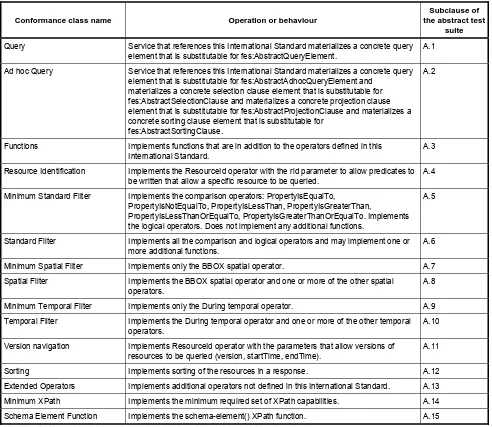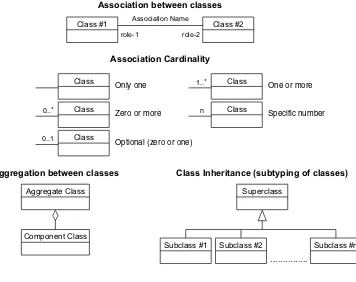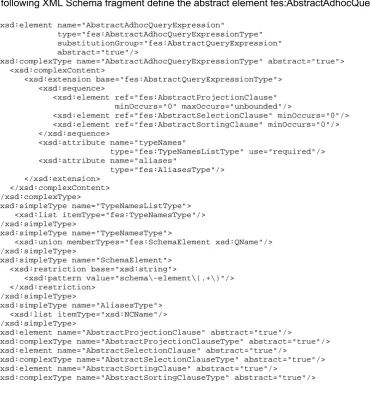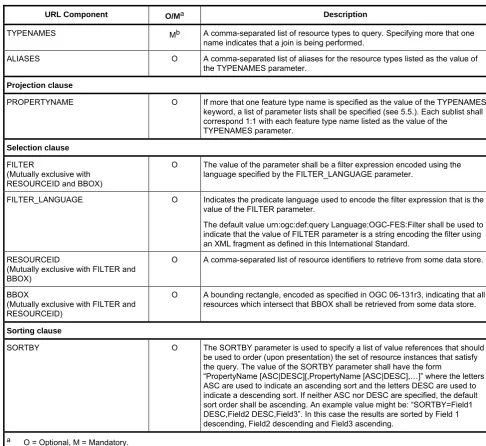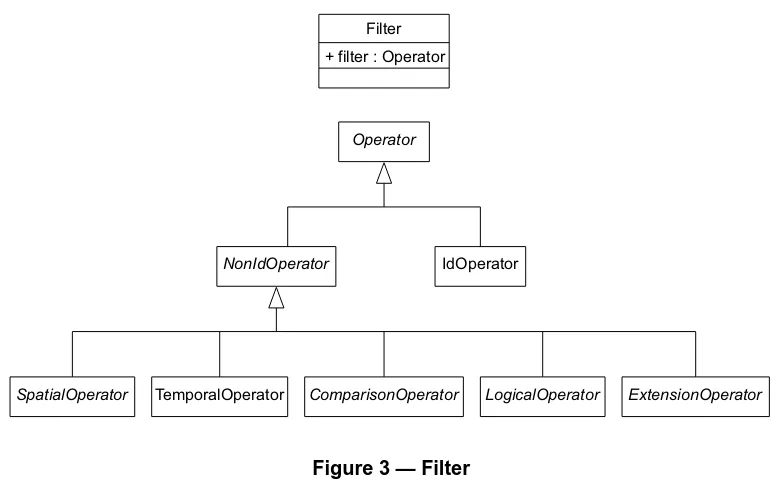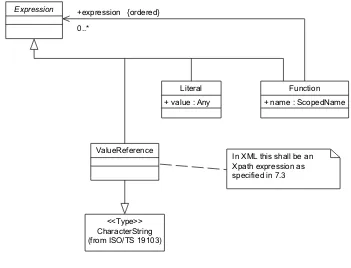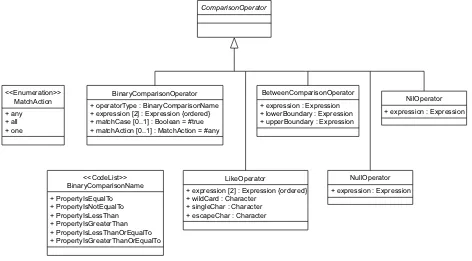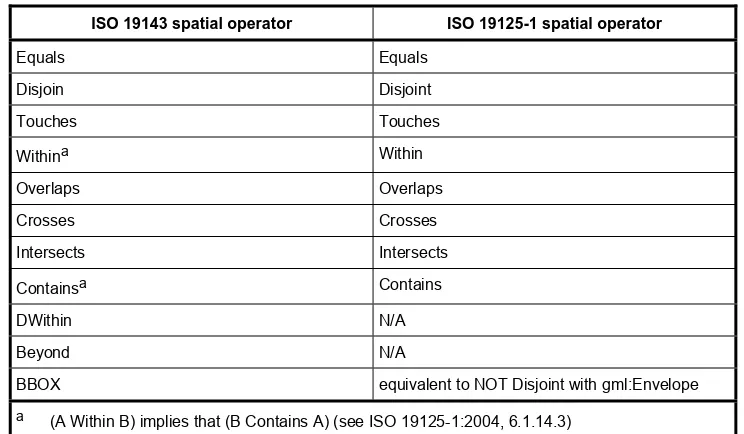Open Geospatial Consortium
Date: 2010-11-22
Reference number of this OpenGIS
®Project Document:
OGC 09-026r1 and ISO/DIS 19143
Version:
2.0.0
Category: OpenGIS
®Implementation Standard
Editor: Peter Vretanos
OpenGIS Filter Encoding 2.0 Encoding Standard
Copyright © 2010 Open Geospatial Consortium
To obtain additional rights of use, visit
http://www.opengeospatial.org/legal/
.
Warning
This document is an approved OGC Standard developed by the OGC Membership. The document is available
for use on a Royalty Free basis. This document is also a joint OGC/ISO document (19143). Please see the
ISO cover page for additional information.
Recipients of this document are invited to submit, with their comments, notification of any relevant patent
rights of which they are aware and to provide supporting documentation.
Document type:
OpenGIS
®Implementation Standard
Document subtype:
Encoding
INTERNATIONAL
STANDARD
ISO
19143
First edition
2010-10-15
Geographic information — Filter
encoding
Contents
Page
Foreword ... iv
Introduction ... v
1
Scope ... 1
2
Conformance ... 2
3
Normative references ... 3
4
Terms and definitions ... 3
5
Conventions ... 6
5.1
Abbreviated terms ... 6
5.2
UML notation ... 7
5.3
Use of examples ... 8
5.4
Namespaces ... 8
5.5
KVP-encoded parameter lists ... 8
5.6
XML Schema fragments ... 9
6
Query expressions ... 9
6.1
General ... 9
6.2
Abstract query expressions ... 9
6.3
Ad hoc query expression... 10
7
Filter ... 13
7.1
General considerations ... 13
7.2
Encoding ... 14
7.3
Expressions ... 14
7.4
Value references ... 15
7.5
Literals ... 17
7.6
Functions ... 18
7.7
Comparison operators ... 19
7.8
Spatial operators ... 22
7.9
Temporal operators ... 26
7.10
Logical operators ... 28
7.11
Object identifiers ... 30
7.12
Extensions ... 31
7.13
Filter capabilities ... 33
7.14
Encoding ... 35
8
Sorting ... 42
8.1
General considerations ... 42
8.2
Encoding ... 42
8.3
Exceptions ... 43
Annex A
(normative)
Conformance testing ... 44
Annex B
(informative)
Filter schema definitions ... 48
Annex C
(informative)
Examples ... 60
Annex D
(informative)
EBNF for XPath subset ... 80
Annex E
(informative)
Abstract model ... 81
Foreword
OGC Declarations
Attention is drawn to the possibility that some of the elements of this document may be the subject of patent
rights. The Open Geospatial Consortium Inc. shall not be held responsible for identifying any or all such patent
rights.
Recipients of this document are requested to submit, with their comments, notification of any relevant patent
claims or other intellectual property rights of which they may be aware that might be infringed by any
implementation of the standard set forth in this document, and to provide supporting documentation.
ISO Declarations
ISO (the International Organization for Standardization) is a worldwide federation of national standards bodies
(ISO member bodies). The work of preparing International Standards is normally carried out through ISO
technical committees. Each member body interested in a subject for which a technical committee has been
established has the right to be represented on that committee. International organizations, governmental and
non-governmental, in liaison with ISO, also take part in the work. ISO collaborates closely with the
International Electrotechnical Commission (IEC) on all matters of electrotechnical standardization.
International Standards are drafted in accordance with the rules given in the ISO/IEC Directives, Part 2.
The main task of technical committees is to prepare International Standards. Draft International Standards
adopted by the technical committees are circulated to the member bodies for voting. Publication as an
International Standard requires approval by at least 75 % of the member bodies casting a vote.
Attention is drawn to the possibility that some of the elements of this document may be the subject of patent
rights. ISO shall not be held responsible for identifying any or all such patent rights.
Introduction
The Filter Encoding standard originated in the OGC.
A fundamental operation performed on a set of data or resources is that of querying in order to obtain a subset
of the data which contains certain desired information that satisfies some query criteria and which is also,
perhaps, sorted in some specified manner.
The term “projection clause” is used to describe an encoding for specifying which subset of resource
properties are presented in the response to a query.
The term “filter or selection clause” is used to describe an encoding of predicates which are typically used in
query operations to specify how data instances in a source dataset should be filtered to produce a result set.
Each data instance in the source set is evaluated using the filter expression. The overall filter expression
always evaluates to true or false. If the expression evaluates to true, the data instance satisfies the expression
and is marked as being in the result set. If the overall filter expression evaluates to false, the data instance is
not in the result set. Thus, the net effect of evaluating a filter expression is a set of data or resource identifiers
which satisfy the predicates in the expression.
The term “sorting clause” is used to describe an encoding for specifying how the data in a response is ordered
prior to being presented.
Such encodings are considered system neutral because using the numerous XML tools available today, XML
encoded projection, selection and sorting clauses can be easily validated, parsed and then transformed into
whatever target query language is required to retrieve or modify resources stored in some persistent object
store. For example an XML encoded query composed of a projection, selection and sorting clauses can be
transformed into a SQL “SELECT … FROM … WHERE … ORDER BY …” statement to fetch data stored in a
SQL-based relational database. Similarly, the same XML encoded query expression can just as easily be
transformed into an XQuery expression in order to retrieve data from XML document.
Geographic information — Filter encoding
1 Scope
This International Standard describes an XML and KVP encoding of a system neutral syntax for expressing
projections, selection and sorting clauses collectively called a query expression.
These components are modular and intended to be used together or individually by other standards which
reference this International Standard.
EXAMPLE 1
ISO 19142 makes use of some or all of these components.
This International Standard defines an abstract component, named AbstractQueryExpression, from which
other specifications can subclass concrete query elements to implement query operations.
This International Standard also defines an additional abstract query component, named
AbstractAdhocQueryExpresison, which is derived from AbstractQueryExpression and from which other
specifications can subclass concrete query elements which follow the following query pattern:
An abstract query element from which service specifications can subclass a concrete query element that
implements a query operation that allows a client to specify a list of resource types, an optional projection
clause, an optional selection clause, and an optional sorting clause to query a subset of resources that
satisfy the selection clause.
This pattern is referred to as an ad hoc query pattern since the server is not aware of the query until it is
submitted for processing. This is in contrast to a stored query expression, which is stored and can be invoked
by name or identifier.
This International Standard also describes an XML and KVP encoding of a system-neutral representation of a
select clause. The XML representation is easily validated, parsed and transformed into a server-specific
language required to retrieve or modify object instances stored in some persistent object store.
EXAMPLE 2
An XML encoded filter can be transformed into a WHERE clause for a SQL SELECT statement to fetch
data stored in a SQL-based relational database. Similarly, and XML encoded filter expression can be transformed into an
XPath or XPointer expression for fetching data from XML documents.
This International Standard defines the XML encoding for the following predicates.
a) A standard set of logical predicates: and, or and not.
b) A standard set of comparison predicates: equal to, not equal to, less than, less than or equal to, greater
than, greater than or equal to, like, is null and between.
c) A standard set of spatial predicates: equal, disjoint, touches, within, overlaps, crosses, intersects,
contains, within a specified distance, beyond a specified distance and BBOX.
d) A standard set of temporal predicates: after, before, begins, begun by, contains, during, ends, equals,
meets, met by, overlaps and overlapped by.
This International Standard defines the XML encoding of metadata that allows a service to declare which
conformance classes, predicates, operators, operands and functions it supports. This metadata is referred to
as Filter Capabilities.
2 Conformance
Few usage scenarios require the full implementation of this International Standard to work. Therefore, service
providers may want to specify requirements for only the subset needed to fulfil their service. Or system
developers may want to document which subset of this International Standard it is that that they have
implemented and conform to. These named conformance classes help in specifying such subsets.
This International Standard defines conformance classes based on the operations and behaviour that a filter
encoding service claims to implement. Table 1 indicates which behaviour shall be implemented for each of the
conformance classes. The described behaviour shall be implemented for the corresponding conformance
class, and the name of the paragraph of the actual detailed abstract test suite in Annex A.
Table 1 — FE conformance classes
Conformance class name Operation or behaviour
Subclause of the abstract test
suite
Query Service that references this International Standard materializes a concrete query element that is substitutable for fes:AbstractQueryElement.
A.1 Ad hoc Query Service that references this International Standard materializes a concrete query
element that is substitutable for fes:AbstractAdhocQueryElement and materializes a concrete selection clause element that is substitutable for fes:AbstractSelectionClause and materializes a concrete projection clause element that is substitutable for fes:AbstractProjectionClause and materializes a concrete sorting clause element that is substitutable for
fes:AbstractSortingClause.
A.2
Functions Implements functions that are in addition to the operators defined in this International Standard.
A.3 Resource Identification Implements the ResourceId operator with the rid parameter to allow predicates to
be written that allow a specific resource to be queried.
A.4 Minimum Standard Filter Implements the comparison operators: PropertyIsEqualTo,
PropertyIsNotEqualTo, PropertyIsLessThan, PropertyIsGreaterThan,
PropertyIsLessThanOrEqualTo, PropertyIsGreaterThanOrEqualTo. Implements the logical operators. Does not implement any additional functions.
A.5
Standard Filter Implements all the comparison and logical operators and may implement one or more additional functions.
A.6 Minimum Spatial Filter Implements only the BBOX spatial operator. A.7 Spatial Filter Implements the BBOX spatial operator and one or more of the other spatial
operators.
A.8 Minimum Temporal Filter Implements only the During temporal operator. A.9 Temporal Filter Implements the During temporal operator and one or more of the other temporal
operators.
A.10 Version navigation Implements ResourceId operator with the parameters that allow versions of
resources to be queried (version, startTime, endTime).
A.11 Sorting Implements sorting of the resources in a response. A.12 Extended Operators Implements additional operators not defined in this International Standard. A.13 Minimum XPath Implements the minimum required set of XPath capabilities. A.14 Schema Element Function Implements the schema-element() XPath function. A.15
3 Normative references
The following referenced documents are indispensable for the application of this document. For dated
references, only the edition cited applies. For undated references, the latest edition of the referenced
document (including any amendments) applies.
ISO 19108:2002, Geographic information — Temporal schema
ISO 19125-1:2004, Geographic information — Simple feature access — Part 1: Common architecture
ISO 19136:2007, Geographic information — Geography Markup Language (GML)
IETF RFC 2396, Uniform Resource Identifiers (URN): Generic Syntax (August 1998)
OGC 06-121r3, OGC Web Services Common Specification, OGC® Implementation Specification
(9 February 2009)
W3C XML, Extensible Markup Language (XML) 1.0 (Third edition), W3C Recommendation (4 February 2004)
W3C XML, Namespaces, Namespaces in XML, W3C Recommendation (14 January 1999)
W3C XML, Path Language, XML Path Language (XPath) 2.0, W3C Recommendation (23 January 2007)
W3C XML, Schema Part 1, XML Schema Part 1: Structures, W3C Recommendation (2 May 2001)
W3C XML, Schema Part 2, XML Schema Part 2: Datatypes, W3C Recommendation (2 May 2001)
4 Terms and definitions
For the purposes of this document, the following terms and definitions apply.
4.1
attribute
〈
XML
〉
name-value pair contained in an
element
[ISO 19136:2007, definition 4.1.3]
NOTE
In this International Standard, an attribute is an XML attribute unless otherwise specified.
4.2
client
software component that can invoke an
operation
from a
server
[ISO 19128:2005, definition 4.1]
4.3
coordinate
one of a sequence of
n
numbers designating the position of a point in
n
-dimensional space
[ISO 19111:2007, definition 4.5]
4.4
coordinate reference system
4.5
coordinate system
set of mathematical rules for specifying how
coordinates
are to be assigned to points
[ISO 19111:2007, definition 4.10]
4.6
element
〈
XML
〉
basic information item of an XML document containing child elements,
attributes
and character data
[ISO 19136:2007, definition 4.1.23]
4.7
feature
abstraction of real world phenomena
[ISO 19101:2002, definition 4.11]
NOTE
A feature can occur as a type or an instance. It is intended that the term “feature type” or “feature instance” be
used when only one is meant.
4.8
feature identifier
identifier that uniquely designates a
feature
instance
[ISO 19142:2010, definition 4.8]
4.9
feature reference
Uniform Resource Identifier
that identifies a
feature
4.10
filter capabilities XML
metadata, encoded in XML, that describes which
predicates
defined in this International Standard a system
implements
4.11
filter expression
predicate expression
encoded using XML
4.12
filter expression processor
component of a system that processes a
filter expression
4.13
function
rule that associates each
element
from a domain (source, or domain of the function) to a unique element in
another domain (target, co-domain, or range)
[ISO 19107:2003, definition 4.41]
4.14
interface
4.15
literal value
constant, explicitly specified value
NOTE
This contrasts with a value that is determined by resolving a chain of substitution (e.g. a variable).
4.16
join predicate
filter expression
that includes one or more clauses that constrain properties from two different entity types
NOTE
In this International Standard, the entity types are
resource
types.
4.17
namespace
〈
XML
〉
collection of names, identified by a URI reference which are used in XML documents as
element
names and
attribute
names
[W3C XML Namespaces]
4.18
operation
specification of a transformation or query that an object may be called to execute
[ISO 19119:2005, definition 4.3]
4.19
predicate
set of computational
operations
applied to a data instance which evaluate to true or false
4.20
predicate expression
formal syntax for describing a
predicate
4.21
property
facet or
attribute
of an object referenced by a name
4.22
request
invocation of an
operation
by a
client
[ISO 19128:2005, definition 4.10]
4.23
resource
asset or means that fulfils a requirement
[ISO 19115:2003, definition 4.10]
NOTE
In this International Standard, a resource is assumed to have identity.
4.24
response
4.25
service
distinct part of the functionality that is provided by an entity through
interfaces
[ISO 19119:2005, definition 4.1]
4.26
server
particular instance of a
service
[ISO 19128:2005, definition 4.12]
4.27
tuple
ordered list of values
[ISO 19136:2007, definition 4.1.63]
NOTE
In this International Standard, the ordered list is generally a finite sequence of
resources
.
4.28
Uniform Resource Identifier
URI
unique identifier for a
resource
, structured in conformance with IETF RFC 2396
[ISO 19136:2007, definition 4.1.65]
NOTE
The general syntax is <scheme>::<scheme-specified-part>. The hierarchical syntax with a namespace is
<scheme>://<authority><path>?<query>.
5 Conventions
5.1 Abbreviated terms
BBOX Bounding
Box
CRS
Coordinate Reference System
EBNF
Extended Backus-Naur Form
EPSG
European Petroleum Survey Group
GML
Geography Markup Language
HTTP
Hypertext Transfer Protocol
HTTPS
Secure Hypertext Transfer Protocol
IETF
Internet Engineering Task Force
KVP Keyword-value
Pair
URN
Uniform Resource Name
UTC Coordinated
Universal
Time
W3C
World Wide Web Consortium
WFS
Web Feature Service
XML
Extensible Markup Language
5.2 UML notation
5.2.1
Figure 1 describes the Unified Modelling Language (UML) notations used in this International
Standard for UML class diagrams.
Class #1 Class #2
Association between classes
Association Namerole-1 role-2
Association Cardinality
Class Class
Class
Class
Aggregate Class
Aggregation between classes
Class Inheritance (subtyping of classes)
Component Class
Superclass
Subclass #1 Subclass #2 Subclass #n
...
Class
n
Only one
Zero or more
Optional (zero or one)
One or more
Specific number
0..*
0..1
1..*
Figure 1 — UML notation in class diagrams
5.2.2
In these class diagrams, the following stereotypes of UML classes are used:
a) <<DataType>> is a descriptor of a set of values that lack identity (independent existence and the
possibility of side effects). A DataType is a class with no operations, whose primary purpose is to hold the
information.
b) <<Enumeration>> is a data type whose instances form a list of alternative literal values. Enumeration
means a short list of well-understood potential values within a class.
c) <<CodeList>> is a flexible enumeration for expressing a long list of potential alternative values. If the list
alternatives are completely known, an enumeration shall be used; if the only likely alternatives are known,
a code list shall be used.
e) <<Type>> is a stereotyped class used for specification of a domain of instances (objects), together with
the operations applicable to the objects. A Type class may have attributes and associations.
f)
<<Union>> is a list of alternate attributes where only one of those attributes may be present at any time.
See also ISO/TS 19103:2005, 6.8.2 and D.8.3.
5.2.3
In this International Standard, the following standard data types are used:
a) CharacterString is a sequence of characters;
b) LocalisedCharacterString is a CharacterString associated with a locale;
c) Boolean is a value specifying TRUE or FALSE;
d) URI is an identifier of a resource that provides more information;
e) Integer is an integer number.
5.3 Use of examples
This International Standard makes use of XML examples. They are meant to illustrate the various aspects of
filters discussed in this International Standard. While every effort has been made to ensure that the examples
are well formed and valid, this goal may be sacrificed for the sake of clarity. For instance, many examples are
formatted in a specific way to highlight a particular aspect that would render the example invalid from the
perspective of an XML validation tool. Furthermore, most examples reference fictitious servers and data.
Thus, this International Standard does not assert that any XML encoded example, copied from this
International Standard, would necessarily execute correctly or validate using a particular XML validation tool.
5.4 Namespaces
Namespaces (a specified in W3C XML Namespaces) are used to discriminate XML vocabularies from one
another. The following namespaces are normatively used in this International Standard:
a) (http://www.opengis.net/fes/2.0): for the Filter vocabulary;
b) (http://www.opengis.net/gml/3.2): for the GML vocabulary.
5.5 KVP-encoded parameter lists
This International Standard defines both XML and KVP encodings for query and filter expressions. Several of
the parameters in the KVP-encoding consist of lists of values (see Table 2) and possibly lists of lists of values.
This subclause defines how to encode lists of values as the value of a parameter.
Parameters consisting of lists shall use the comma (“,”) as the delimiter between items in the list. In addition,
multiple lists may be specified as the value of a parameter by enclosing each list in parentheses; “(“, ”)”.
EXAMPLE 1
This example shows a list of items.
PARAMETER=item1,item2,item3,item4a%2Citem4b
This list consists of four values: item1, item2, item3 and the value “item4a,item4b”.
NOTE
In this example, the embedded comma in the last item has been encoded as per IETF RFC 2396 in order to
distinguish it from the commas used in the list of delimit list entries.
EXAMPLE 2
This example shows multiple lists of items assigned to a single parameter.
5.6 XML Schema fragments
This International Standard makes use of XML Schema (as given in W3C XML Schema Part 1 and W3C XML
Schema Part 2) fragments to define the XML encoding of the components of a filter expression. These XML
Schema fragments are collected into a set of consolidated schema files in Annex B.
6 Query expressions
6.1 General
A query expression (see Figure 2) is an action that performs a search over some set of resources and returns
a subset of those resources. Other standards that reference this International Standard shall assert what a
resource is.
EXAMPLE
A WFS would assert that a resource is a feature.
+ handle [0..1] : CharacterString QueryExpression
+ types [1..*] : Type {ordered} + projection [0..1] : Any + selection [0..1] : Any + sorting [0..1] : Any
Type
+ name : TypeName + alias [0..1] : LocalName
<<Union>> TypeName
+ ofType : ScopedName + ofKind : ScopedName AdhocQueryExpression
Figure 2 — Query expressions
6.2 Abstract query expressions
This International Standard defines the abstract element fes:AbstractQueryExpression as the head of a
substitution group of query expressions. The element fes:AbstractQueryExpression is defined by the following
XML Schema fragment:
<xsd:element name="AbstractQueryExpression"
type="fes:AbstractQueryExpressionType" abstract="true"/> <xsd:complexType name="AbstractQueryExpressionType" abstract="true"> <xsd:attribute name="handle" type="xsd:string"/>
</xsd:complexType>
The fes:AbstractQueryExpression element defines the handle attribute which can be used to assign
user-defined identifier to the query expression for the purpose of error handling or correlating the response to a
query, from within a series of queries, with the source query expression.
6.3 Ad hoc query expression
6.3.1 General considerations
A fundamental type of query expression is the ad hoc query expression. It is ad hoc in the sense that the
query is not known before the time it is being executed as, for example, a stored query would be.
An ad hoc query expression is a query expression that contains the names of one or more resource types to
query, an optional projection clause enumerating the properties of the resource to present in the response, an
option selection clause that constraints the properties of those resources types in order to define a result set
and an optional sorting clause specifying the order in which the result set is presented.
This subclause defines the head of an substitution group called fes:AbstractAdhocQueryExpression from
which standards that reference this International Standard can derive concrete ad hoc query expressions.
6.3.2 XML encoding
The following XML Schema fragment define the abstract element fes:AbstractAdhocQueryExpression
<xsd:element name="AbstractAdhocQueryExpression"
type="fes:AbstractAdhocQueryExpressionType" substitutionGroup="fes:AbstractQueryExpression" abstract="true"/>
<xsd:complexType name="AbstractAdhocQueryExpressionType" abstract="true"> <xsd:complexContent>
<xsd:extension base="fes:AbstractQueryExpressionType"> <xsd:sequence>
<xsd:element ref="fes:AbstractProjectionClause" minOccurs="0" maxOccurs="unbounded"/>
<xsd:element ref="fes:AbstractSelectionClause" minOccurs="0"/> <xsd:element ref="fes:AbstractSortingClause" minOccurs="0"/> </xsd:sequence>
<xsd:attribute name="typeNames"
type="fes:TypeNamesListType" use="required"/> <xsd:attribute name="aliases"
type="fes:AliasesType"/> </xsd:extension>
</xsd:complexContent> </xsd:complexType>
<xsd:simpleType name="TypeNamesListType"> <xsd:list itemType="fes:TypeNamesType"/> </xsd:simpleType>
<xsd:simpleType name="TypeNamesType">
<xsd:union memberTypes="fes:SchemaElement xsd:QName"/> </xsd:simpleType>
<xsd:simpleType name="SchemaElement"> <xsd:restriction base="xsd:string">
<xsd:pattern value="schema\-element\(.+\)"/> </xsd:restriction>
</xsd:simpleType>
<xsd:simpleType name="AliasesType"> <xsd:list itemType="xsd:NCName"/> </xsd:simpleType>
<xsd:element name="AbstractProjectionClause" abstract="true"/>
<xsd:complexType name="AbstractProjectionClauseType" abstract="true"/> <xsd:element name="AbstractSelectionClause" abstract="true"/>
<xsd:complexType name="AbstractSelectionClauseType" abstract="true"/> <xsd:element name="AbstractSortingClause" abstract="true"/>
<xsd:complexType name="AbstractSortingClauseType" abstract="true"/>
6.3.3 KVP-encoding
Table 2 — KVP-encoding for ad hoc query expression
URL Component O/Ma Description
TYPENAMES Mb A comma-separated list of resource types to query. Specifying more that one name indicates that a join is being performed.
ALIASES O A comma-separated list of aliases for the resource types listed as the value of the TYPENAMES parameter.
Projection clause
PROPERTYNAME O If more that one feature type name is specified as the value of the TYPENAMES keyword, a list of parameter lists shall be specified (see 5.5.). Each sublist shall correspond 1:1 with each feature type name listed as the value of the
TYPENAMES parameter.
Selection clause
FILTER
(Mutually exclusive with RESOURCEID and BBOX)
O The value of the parameter shall be a filter expression encoded using the language specified by the FILTER_LANGUAGE parameter.
FILTER_LANGUAGE O Indicates the predicate language used to encode the filter expression that is the value of the FILTER parameter.
The default value urn:ogc:def:query Language:OGC-FES:Filter shall be used to indicate that the value of FILTER parameter is a string encoding the filter using an XML fragment as defined in this International Standard.
RESOURCEID
(Mutually exclusive with FILTER and BBOX)
O A comma-separated list of resource identifiers to retrieve from some data store.
BBOX
(Mutually exclusive with FILTER and RESOURCEID)
O A bounding rectangle, encoded as specified in OGC 06-131r3, indicating that all resources which intersect that BBOX shall be retrieved from some data store.
Sorting clause
SORTBY O The SORTBY parameter is used to specify a list of value references that should be used to order (upon presentation) the set of resource instances that satisfy the query. The value of the SORTBY parameter shall have the form
“PropertyName [ASC|DESC][,PropertyName [ASC|DESC],…]” where the letters ASC are used to indicate an ascending sort and the letters DESC are used to indicate a descending sort. If neither ASC nor DESC are specified, the default sort order shall be ascending. An example value might be: “SORTBY=Field1 DESC,Field2 DESC,Field3”. In this case the results are sorted by Field 1 descending, Field2 descending and Field3 ascending.
a O = Optional, M = Mandatory.
b Standards that reference this International Standard may change the requirement for the TYPENAME parameter. In such cases,
the referencing standard shall document whether the TYPENAME parameter is mandatory, optional or mandatory in some cases and optional in others.
6.3.3.1
Parameter discussion
6.3.3.1.1
typeNames parameter
The mandatory typeNames parameter shall be used within an ad hoc query expression to encode the names
of one or more correlated resource types to be queried. Individual resource type names shall be encoded as
QName (as given in W3C XML Schema Part 2).
NOTE
For the KVP-encoding of the typeNames parameter, see 5.5 for encoding lists of values.
6.3.3.1.2
aliases parameter
The optional aliases parameter may be used within an ad hoc query expression to specify alternate names for
the resource type names specified as the value of the typeNames parameter. A resource type alias may be
used anywhere; the resource type name may be used within the context of the query expression.
The number of list elements in the value of the aliases parameter shall match the number of corresponding
resource type names in the value of the typeNames parameter and shall be correlated 1:1.
EXAMPLE 1
< … typeNames=“ns1:ResourceType1, ns2:ResourceType2” aliases=“A B” …>
This example encodes an ad hoc query expression fragment that queries the resource types ns1:ResourceType1 and
ns2:ResourceType2 which are aliased to A and B. Thus, the tokens A or B can be used within the filter expression of the
query expression as alternate names for the resource types ns1:ResourceType1 and ns2:ResourceType2.
Each alias specified in the value of aliases attribute shall be unique within the context of a single query
expression.
If the aliases attribute is used, an alias shall be specified for each resource type name listed as the value of
typeNames attribute.
Aliases are typically used in query expressions that perform a join operation to support self-joins. That is a join
of one resource type back to itself.
EXAMPLE 2
typeNames=“myns:ResType1 myns:ResType1” aliases=“a b”
In this example, the first resource type, myns:ResType1, is aliased to the name “a” and the second resource type,
myns:Feat1, is aliased to the name “b”. Thus properties from the first instance of myns:ResType1 can be referenced in a
request as “/a/myns:property_name” and properties from the second instance of myns:ResType2 can be referenced in a
request as “/b/myns:property_name” where the token “myns:property_name” is used as a place holder for the name of any
property of the resource type myns:ResType1.
6.3.3.1.3
Projection clause
A projection clause encodes a list of optional resource properties that shall be available in a query response.
For XML-encoded requests, specifications which implement the projection clause of an ad hoc query
expression shall define a concrete element derived from fes:AbstractAdhocProjectionClause.
For KVP-encoded requests, the PROPERTYNAME keyword shall be used to encode the projection clause.
The value of the PROPERTYNAME keyword shall be a comma-separated list of property names.
6.3.3.1.4
Selection clause
The selection clause defines a set of query predicates that shall be applied to a dataset in order to define a
subset of data to be operated upon.
Services that implement this International Standard shall use the fes:Filter element, which is substitutable for
fes:AbstractSelectionClause, to encode the selection clause of a query expression.
For XML-encoded requests, the selection clauses shall be encoded using the fes:Filter element.
6.3.3.1.5
Join queries
A join query finds tuples (i.e. pairs, triples, etc.) of resources, among a list of resource types, that satisfy a filter
expression which includes join predicates. If the filter expression is satisfied, that tuple of resources is
considered to be in the result set of the query expression.
A join query is encoded by:
a) listing the resource types to join using the typeNames parameter (see 6.3.3.1.1);
b) specifying join predicates in the selection clause that reference properties of the resource types listed as
the values of the typeNames parameter (see 6.3.3.1.1).
Services that implement join queries shall implement an inner join meaning that only resource tuples which
match the join conditions shall be returned in the result set.
6.3.3.1.6
schema-element() function
If the list of values for the typeNames parameters contains a single QName then the schema-element()
function can be used to trigger a sequence of queries on the specified resource type and any resource type
whose object elements are in the substitution group of the specified resource type.
EXAMPLE typeNames=“schema-element(ns1:Vehicles)”
might, along with ns1:Vehicle, query the resource types
ns1:Cars, ns1:Boats, etc …
The schema-element() function shall not be used if a join operation (see 6.3.3.1.5) is being performed.
6.3.3.1.7
Sorting clause
A sorting clause can be used to assert the order in which resources shall appear in response to an ad hoc
query expression.
For XML-encoded requests, standards that reference this International Standard shall use the fes:SortBy
element (see Clause 9), which is substitutable for fes:AbstractSortingClause, to encode the sorting clause of
an ad hoc query expression.
For KVP-encoded requests, the keyword SORTBY shall be used to encode a sorting clause (see Table 2).
7 Filter
7.1 General considerations
A filter (see Figure 3) is used to identify a subset of resources from a collection of resources whose property
values satisfy a set of logically connected predicates. If the property values of a resource satisfy all the
predicates in a filter then that resource is considered to be part of the resulting subset.
+ filter : Operator Filter
Operator
NonIdOperator IdOperator
SpatialOperator TemporalOperator ComparisonOperator LogicalOperator ExtensionOperator
Figure 3 — Filter
7.2 Encoding
The root element of a filter expression, fes:Filter, is defined by the following XML Schema fragment:
<xsd:element name="Filter"
type="fes:FilterType"
substitutionGroup="fes:AbstractSelectionClause"/> <xsd:complexType name="FilterType">
<xsd:complexContent>
<xsd:extension base="fes:AbstractSelectionClauseType"> <xsd:sequence>
<xsd:group ref="fes:FilterPredicates"/> </xsd:sequence>
</xsd:extension> </xsd:complexContent> </xsd:complexType>
<xsd:group name="FilterPredicates"> <xsd:choice>
<xsd:element ref="fes:comparisonOps"/> <xsd:element ref="fes:spatialOps"/> <xsd:element ref="fes:temporalOps"/> <xsd:element ref="fes:logicOps"/> <xsd:element ref="fes:extensionOps"/> <xsd:element ref="fes:Function"/>
<xsd:element ref="fes:_Id" maxOccurs="unbounded"/> </xsd:choice>
</xsd:group>
<xsd:element name="extensionOps"
type="fes:ExtensionOpsType" abstract="true"/>
<xsd:complexType name="ExtensionOpsType" abstract="true"/>
The elements contained within the fes:Filter element are discussed in detail in subsequent clauses.
7.3 Expressions
7.3.1 General considerations
In XML this shall be an Xpath expression as specified in 7.3 + value : Any
Literal Expression
ValueReference
+ name : ScopedName Function
<<Type>> CharacterString (from ISO/TS 19103) +expression {ordered}
0..*
Figure 4 — Expression
7.3.2 Encoding
An expression can be formed using the following XML elements:
• fes:ValueReference • fes:Literal • fes:Function
These elements all belong to the substitution group expression and can be used wherever an expression is
called for. In addition, the XML fragments formed by combining these elements are themselves expressions
and can be used wherever an expression is called for.
The
fes:expression
element is an abstract element and its only purpose is to act as a placeholder for the
elements and combinations of elements that can be used to form expressions.
The XML Schema fragment that defines the abstract fes:expression element is:
<xsd:element name="expression" abstract="true"/>
7.4 Value references
7.4.1 General considerations
A value reference is a string that represents a value that is to be evaluated by a predicate. The string can, for
example, be the name of a property of a resource or a path expression that represents some value that is part
of the property of a resource. At runtime, a predicate is evaluated by replacing the value reference by the
value it refers to and then executing whatever test is encoded by the predicate.
7.4.2 Encoding
7.4.3 Property names in GML
The fes:ValueReference element can used to specify the name of any property of an object whose value shall
be tested by a predicate in a filter expression. For services that implement this International Standard and use
GML (see ISO 19136), property names shall be encoded using XML elements as described in the Extensible
Markup Language (XML) 1.0 (see W3C XML) specification. In addition, GML property names may be qualified
with a namespace, in which case the name shall conform to the Namespaces in XML (as given in W3C XML
Namespaces) specification. The following definition is taken from Clauses 2 and 3 of W3C XML Namespaces:
Names and Tokens
[4] NCName ::= (Letter | '_') (NCNameChar)* /* An XML Name, minus the ":" */
[5] NCNameChar ::= Letter | Digit | '.' | '-' | '_' | CombiningChar | Extender [6] QName ::= (Prefix ':')? LocalPart
[7] Prefix ::= NCName [8] LocalPart ::= NCName
The definitions of the components Letter, Digit, CombiningChar and Extender are given in Annex B of
Namespaces in XML (W3C XML Namespaces).
EXAMPLE 1
Examples of valid property names are: age, temperature, _KHz, INWATERA_1M.WKB_GEOM
EXAMPLE 2
Examples of invalid property names are: +Domain, 123_SomeName
7.4.4 XPath expressions
In cases where the data model of the service that implements this International Standard is represented as
XML, as is the case with ISO 19142 where GML (see ISO 19136) is used, value references can refer to parts
of a complex property and shall be encoded using the XML Path Language (given in W3C XML Path
Language).
The XML Path Language (as given in W3C XML Path Language) specification is a language for addressing
parts of an XML document, or in the case of this International Standard, for referencing XML elements and
attributes that represent the properties of an object encoded in XML.
This International Standard does not require that a filter expression processor support the full XPath language.
In order to keep the implementation entry cost as low as possible, services that implement this specification
and require the use of XPath, shall support a subset of the XPath language. The following set of rules defines
this subset of the XPath language.
a) The abbreviated form of the child and attribute axis specifier (see W3C XML Path Language) shall be
supported.
b) The context node shall be the resource element, except in the case of a join operation, in which case the
context node shall be the parent of the resource element.
c) Each step in the path may include an XPath predicate.
d) At least the following predicate expression items shall be supported:
1) a positive non-zero integer may be used to indicate which child of the context node should be
selected (i.e. an index). This allows ordered properties with repeatable values to be specifically
referenced;
3) equality tests of the form “child=value” may be used to identify a specific object property by
constraining the child elements of the property. Equality tests can be logically combined using the
“and” or “or” operators.
NOTE
Consider the following example:
<Building>
<name>City hall</name> <addresses>
<Address>
<city>Bonn</city>
<street>Oxfordstrasse</street> <number>1</number>
</Address> <Address>
<city>Bonn</city>
<street>Breitestrasse</street> <number>5</number>
</Address> </addresses> </Building>
<Filter>
<PropertyIsEqualTo>
<ValueReference>addresses/Address/city</ValueReference> <Literal>Bonn</Literal>
</PropertyIsEqualTo> </Filter>
In this example “City hall” has two address values. The following XPath expression can be used
to reference the number of the first Address value:
addresses/Address[street="Oxfordstrasse"]/number
e) The last step of the XPath expression shall be a resource property or sub-component of a resource
property.
f)
The function schema-element() may be supported.
Other standards that reference this International Standard shall declare whether implementing the
schema-element() function is mandatory or optional.
EXAMPLE 1
The WFS standard (see ISO 19142) declares that implementing the schema-element() function is
optional and defines a conformance class to test whether a WFS implementation supports that method or not.
Other standards that reference this International Standard may extend this XPath subset as required.
EXAMPLE 2
The WFS standard (see ISO 19142) extends this subset by allowing the use of an accessor function
called wfs:valueOf().
Annex D defines the subset of the XPath grammar for the path expressions used in this International Standard.
It follows the EBNF (see ISO/IEC 14977) notation defined in the XPath 2.0 specification, Appendix A “XPath
grammar” (see http://www.w3.org/TR/xpath20/#nt-bnf).
7.5 Literals
7.5.1 General considerations
7.5.2 Encoding
The following XML Schema fragment defines the fes:Literal element:
<xsd:element name="Literal" type="fes:LiteralType" substitutionGroup="fes:expression"/>
<xsd:complexType name="LiteralType" mixed="true"> <xsd:sequence>
<xsd:any minOccurs="0"/> </xsd:sequence>
<xsd:attribute name="type" type="xsd:QName"/> </xsd:complexType>
The fes:Literal element is used to encode any explicitly stated value. If the literal value is a geometric value,
the value shall be encoded following the rules of GML (defined in ISO 19136).
Literals can, optionally, be typed using the type attribute. The value of the attribute type is the name of type
from some type system.
EXAMPLE
The following XML fragment: <Literal type=“xs:date”>1963-10-13</Literal> encodes a date value. The
type of the value is xs:date as defined in (see W3C XML Schema Part 2).
7.6 Functions
7.6.1 General considerations
This section defines the encoding of single valued functions using the fes:Function element. A function is a
named procedure that performs a distinct computation. A function can accept zero or more arguments as
input and generates a single result.
Functions may be used to extend the filter syntax with additional operators that can be used in filter
expressions.
If a standard that references this International Standard extends the filter syntax using the fes:Function
element, any additional functions shall be documented in the referencing standard. An implementation of the
referencing standard shall, in its filter capabilities (see 7.14.6), declare these additional functions.
7.6.2 Encoding
The following XML Schema fragment declares the fes:Function element:
<xsd:element name="Function" type="fes:FunctionType" substitutionGroup="fes:expression"/>
<xsd:complexType name="FunctionType"> <xsd:sequence>
<xsd:element ref="fes:expression"
minOccurs="0" maxOccurs="unbounded"/> </xsd:sequence>
<xsd:attribute name="name" type="xsd:string" use="required"/> </xsd:complexType>
A function is composed of the name of the function, encoded using the attribute “name”, and zero or more
arguments contained within the fes:Function element. The arguments themselves are in-turn expressions
(see 7.3) and shall appear in the order in which they are defined in the filter capabilities document (see 7.14.6).
EXAMPLE
The following XML fragment uses a function to invoke an operator named “ClassifiedAs” to find roads
classified as major highways within some area of interest. The function accepts two arguments; the name of a
classification scheme, and the name of a node within that classification scheme.
<fes:Filter> <fes:And>
<fes:Function name="ClassifiedAs">
<fes:Literal>RoadTaxonomy</fes:Literal> <fes:Literal>Major Highway</fes:Literal> </fes:Function>
<fes:BBOX>
<fes:ValueReference>/RS1/geometry</fes:ValueReference> <gml:Envelope srsName="urn:ogc:def:crs:EPSG::1234"> <gml:lowerCorner>10 10</gml:lowerCorner>
<gml:upperCorner>20 20</gml:upperCorner> </gml:Envelope>
</fes:BBOX> </fes:And> </fes:Filter>
7.7 Comparison operators
7.7.1 General considerations
A comparison operator (see Figure 5) is used to form expressions that evaluate the mathematical comparison
between two arguments. If the arguments satisfy the comparison then the expression evaluates to true.
Otherwise the expression evaluates to false.
A service that implements this International Standard shall, in its filter capabilities (see 7.14.3), declare which
comparison operators it supports.
ComparisonOperator
+ operatorType : BinaryComparisonName + expression [2] : Expression {ordered} + matchCase [0..1] : Boolean = #true + matchAction [0..1] : MatchAction = #any
BinaryComparisonOperator
+ any + all + one
<<Enumeration>> MatchAction
BetweenComparisonOperator + expression : Expression + lowerBoundary : Expression + upperBoundary : Expression
NilOperator
+ expression : Expression
+ expression [2] : Expression {ordered} + wildCard : Character
+ singleChar : Character + escapeChar : Character
LikeOperator NullOperator + expression : Expression + PropertyIsEqualTo
+ PropertyIsNotEqualTo + PropertyIsLessThan + PropertyIsGreaterThan + PropertyIsLessThanOrEqualTo + PropertyIsGreaterThanOrEqualTo
<<CodeList>> BinaryComparisonName
7.7.2 Encoding
The following XML Schema fragment defines the XML encoding for comparison operators:
<xsd:element name="comparisonOps"
type="fes:ComparisonOpsType" abstract="true"/>
<xsd:complexType name="ComparisonOpsType" abstract="true"/> <xsd:element name="PropertyIsEqualTo"
type="fes:BinaryComparisonOpType" substitutionGroup="fes:comparisonOps"/> <xsd:element name="PropertyIsNotEqualTo"
type="fes:BinaryComparisonOpType" substitutionGroup="fes:comparisonOps"/> <xsd:element name="PropertyIsLessThan"
type="fes:BinaryComparisonOpType" substitutionGroup="fes:comparisonOps"/> <xsd:element name="PropertyIsGreaterThan"
type="fes:BinaryComparisonOpType" substitutionGroup="fes:comparisonOps"/> <xsd:element name="PropertyIsLessThanOrEqualTo" type="fes:BinaryComparisonOpType" substitutionGroup="fes:comparisonOps"/> <xsd:element name="PropertyIsGreaterThanOrEqualTo" type="fes:BinaryComparisonOpType" substitutionGroup="fes:comparisonOps"/> <xsd:element name="PropertyIsLike"
type="fes:PropertyIsLikeType"
substitutionGroup="fes:comparisonOps"/> <xsd:element name="PropertyIsNull"
type="fes:PropertyIsNullType"
substitutionGroup="fes:comparisonOps"/> <xsd:element name="PropertyIsNil"
type="fes:PropertyIsNilType"
substitutionGroup="fes:comparisonOps"/> <xsd:element name="PropertyIsBetween"
type="fes:PropertyIsBetweenType" substitutionGroup="fes:comparisonOps"/> <xsd:complexType name="BinaryComparisonOpType"> <xsd:complexContent>
<xsd:extension base="fes:ComparisonOpsType"> <xsd:sequence>
<xsd:element ref="fes:expression" minOccurs="2" maxOccurs="2"/> </xsd:sequence>
<xsd:attribute name="matchCase" type="xsd:boolean" use="optional" default="true"/>
<xsd:attribute name="matchAction" type="fes:MatchActionType" use="optional" default="Any"/>
</xsd:extension> </xsd:complexContent> </xsd:complexType>
<xsd:simpleType name="MatchActionType"> <xsd:restriction base="xsd:string"> <xsd:enumeration value="All"/> <xsd:enumeration value="Any"/> <xsd:enumeration value="One"/> </xsd:restriction>
</xsd:simpleType>
<xsd:complexType name="PropertyIsLikeType"> <xsd:complexContent>
<xsd:extension base="fes:ComparisonOpsType"> <xsd:sequence>
<xsd:element ref="fes:expression" minOccurs="2" maxOccurs="2"/> </xsd:sequence>
<xsd:attribute name="wildCard" type="xsd:string" use="required"/> <xsd:attribute name="singleChar" type="xsd:string" use="required"/> <xsd:attribute name="escapeChar" type="xsd:string" use="required"/> </xsd:extension>
</xsd:complexContent> </xsd:complexType>
<xsd:complexType name="PropertyIsNullType"> <xsd:complexContent>
<xsd:extension base="fes:ComparisonOpsType"> <xsd:sequence>
</xsd:sequence> </xsd:extension> </xsd:complexContent> </xsd:complexType>
<xsd:complexType name="PropertyIsNilType"> <xsd:complexContent>
<xsd:extension base="fes:ComparisonOpsType"> <xsd:sequence>
<xsd:element ref="fes:expression" minOccurs="0"/> </xsd:sequence>
<xsd:attribute name="nilReason" type="xsd:string"/> </xsd:extension>
</xsd:complexContent> </xsd:complexType>
<xsd:complexType name="PropertyIsBetweenType"> <xsd:complexContent>
<xsd:extension base="fes:ComparisonOpsType"> <xsd:sequence>
<xsd:element ref="fes:expression"/>
<xsd:element name="LowerBoundary" type="fes:LowerBoundaryType"/> <xsd:element name="UpperBoundary" type="fes:UpperBoundaryType"/> </xsd:sequence>
</xsd:extension> </xsd:complexContent> </xsd:complexType>
<xsd:complexType name="LowerBoundaryType"> <xsd:choice>
<xsd:element ref="fes:expression"/> </xsd:choice>
</xsd:complexType>
<xsd:complexType name="UpperBoundaryType"> <xsd:sequence>
<xsd:element ref="fes:expression"/> </xsd:sequence>
</xsd:complexType>
7.7.3 Prameter discussion
7.7.3.1
Binary comparisons
This International Standard defines a standard set of comparison operators (=,<,>,>=,<=,<>): equal to, less
than, greater than, less than or equal to, greater than or equal to and not equal to. These comparison
operators are encoded using the complex type BinaryComparisonOpType.
7.7.3.2
matchCase parameter
The matchCase attribute, which is of type Boolean, shall be used to specify how a filter expression processor
should perform string comparisons. A value of true means that string comparisons shall match case. This shall
be the default value. The value false means that string comparisons are performed caselessly.
7.7.3.3
matchAction parameter
The matchAction attribute can be used to specify how the comparison predicate shall be evaluated for a
collection of values (e.g. in XML, properties having maxOccurs > 1) and not including some additional context
to identify a specific value from the collection to be tested. Possible values for the attribute are: All,
Any or
One. A value of All means that all values in the collection shall satisfy the predicate. A value of Any means
that any of the value in the collection can satisfy the predicate. Finally, a value of One means that only one of
the values in the collection shall satisfy the predicate.
EXAMPLE The
following
example
illustrates the use of the matchAction attribute. Consider the following XML
fragment, which is an instance of a GML (see ISO 19136) feature:
<ex:Building gml:id="b123">
<gml:name>175 Fifth Ave.</gml:name> <gml:name>Flatiron</gml:name> <gml:name>Acme Building</gml:name> <!-- ... -->
</ex:Building>
and consider the following filter expression:
<fes:Filter>
<fes:PropertyIsEqualTo matchAction="...">
<fes:ValueReference>gml:name</fes:ValueReference> <fes:Literal>Flatiron</fes:Literal>
</fes:PropertyIsEqualTo> </fes:Filter>
If the value of the matchAction attribute is set to Any, this predicate will evaluate to true since there is at least
one gml:name value that satisfied the predicate. If the value of the matchAction attribute is All, this predicate
will evaluate to false since not all gml:name values are Flatiron. Finally, if the matchAction attribute is set to
One then the expression will evaluate to true since only one gml:name value is Flatiron.
If the value of the matchAction attribute is Any or All, the ValueReference XPath expression shall not include
an index predicate. If the matchAction attribute is One an XPath index predicate may be specified and the
predicate shall only evaluate to true if not only one value matches the predicate but the specific value
indicates by the index matches the value.
7.7.3.4
PropertyIsLike operator
The PropertyIsLike element is intended to encode a character string comparison operator with pattern
matching. A combination of regular characters, the wildCard character, the singleChar character, and the
escapeChar character define the pattern. The wildCard character matches zero or more characters. The
singleChar character matches exactly one character. The escapeChar character is used to escape the
meaning of the wildCard, singleChar and escapeChar itself.
7.7.3.5
PropertyIsNull operator
The PropertyIsNull operator tests the specified property to see if it exists in the resource being evaluated. This
corresponds to checking whether the property exists in the real-world.
7.7.3.6
PropertyIsNil operator
The PropertyIsNil operator tests the content of the specified property and evaluates if it is nil. The operator
can also evaluate the nil reason using the nilReason parameter. The implied operator for evaluating the nil
reason is “equals”.
7.7.3.7
PropertyIsBetween operator
The PropertyIsBetween element is defined as a compact way of encoding a range check. The lower and
upper boundary values are inclusive.
7.8 Spatial operators
7.8.1 General considerations
{operatorType<>#BBOX implies operand1->notEmpty() and operatorType=#BBOX implies operand2.envelope->notEmpty()}
SpatialOperator
+ valueReference : ValueReference + operatorType : DistanceOperatorName + geometry : GM_Object
+ distance : Measure
DistanceOperator BinarySpatialOperator + operatorType : SpatialOperatorName + operand1 [0..1] : ValueReference + operand2 : SpatialDescription
+ BBOX + Equals + Disjoint + Intersects + Touches + Crosses + Within + Contains + Overlaps
<<CodeList>> SpatialOperatorName
+ Beyond + DWithin
<<CodeList>> DistanceOperatorName
+ geometry : GM_Object + envelope : GM_Envelope + valueReference : ValueReference
<<Union>> SpatialDescription
Figure 6 — SpatialOperator
Table 3 maps the spatial operators described in this International Standard to the set of spatial operators
defined in ISO 19125-1.
Table 3 — Mapping of ISO 19143 spatial operators to ISO 19125-1 spatial operators
ISO 19143 spatial operator ISO 19125-1 spatial operator
Equals Equals Disjoin Disjoint Touches Touches
Withina Within
Overlaps Overlaps Crosses Crosses Intersects Intersects
Containsa Contains
DWithin N/A Beyond N/A BBOX equivalent to NOT Disjoint with gml:Envelope
a (A Within B) implies that (B Contains A) (see ISO 19125-1:2004, 6.1.14.3)
7.8.2 Encoding
The following XML Schema fragment defines the XML encoding for spatial operators:
<xsd:element name="spatialOps" type="fes:SpatialOpsType" abstract="true"/> <xsd:complexType name="SpatialOpsType" abstract="true"/>
<xsd:element name="Equals"
type="fes:BinarySpatialOpType" substitutionGroup="fes:spatialOps"/> <xsd:element name="Disjoint"
type="fes:BinarySpatialOpType" substitutionGroup="fes:spatialOps"/> <xsd:element name="Touches"
type="fes:BinarySpatialOpType" substitutionGroup="fes:spatialOps"/> <xsd:element name="Within"
type="fes:BinarySpatialOpType" substitutionGroup="fes:spatialOps"/> <xsd:element name="Overlaps"
type="fes:BinarySpatialOpType" substitutionGroup="fes:spatialOps"/> <xsd:element name="Crosses"
type="fes:BinarySpatialOpType" substitutionGroup="fes:spatialOps"/> <xsd:element name="Intersects"
type="fes:BinarySpatialOpType" substitutionGroup="fes:spatialOps"/> <xsd:element name="Contains"
type="fes:BinarySpatialOpType" substitutionGroup="fes:spatialOps"/> <xsd:element name="DWithin"
type="fes:DistanceBufferType"
substitutionGroup="fes:spatialOps"/> <xsd:element name="Beyond"
type="fes:DistanceBufferType"
substitutionGroup="fes:spatialOps"/> <xsd:element name="BBOX"
type="fes:BBOXType"
substitutionGroup="fes:spatialOps"/> <xsd:complexType name="BinarySpatialOpType"> <xsd:complexContent>
<xsd:extension base="fes:SpatialOpsType"> <xsd:sequence> </xsd:complexType>
<xsd:complexType name="BBOXType"> <xsd:complexContent>
<xsd:extension base="fes:SpatialOpsType"> <xsd:sequence> </xsd:complexType>
<xsd:complexType name="DistanceBufferType"> <xsd:complexContent>
<xsd:extension base="fes:SpatialOpsType"> <xsd:sequence> </xsd:complexType>
